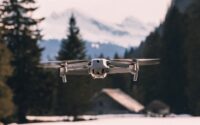Are drone blades dangerous
When it comes to the question of whether drone blades are dangerous, it is essential to consider several factors. While drones offer numerous benefits and have become increasingly popular for recreational and professional purposes, their spinning blades can pose certain risks.
First and foremost, drone blades are typically made of sturdy materials such as carbon fiber or plastic, designed to withstand impact and maintain stability during flight. However, if a drone blade comes into contact with a person or object, it can cause significant injury or damage. This is especially true if the blades are spinning at high speeds, which is the case during flight.
To mitigate these risks, manufacturers have implemented various safety measures. Many drones are equipped with guards or propeller cages, which act as a protective barrier around the blades, reducing the likelihood of direct contact with people or objects. These guards can help prevent accidents and minimize the potential for injuries.
Another critical aspect to consider is the skill and responsibility of the drone operator. It is crucial for drone pilots to undergo proper training and education to ensure they understand the potential risks associated with drone blades. They should be aware of the safety guidelines and regulations set by aviation authorities and follow them diligently. Responsible drone operation includes maintaining a safe distance from people, animals, and property to prevent accidents or damage caused by the spinning blades.
Furthermore, advancements in drone technology have introduced additional safety features. Some drones now come with obstacle detection and avoidance systems, which use sensors to detect potential obstacles and adjust the flight path accordingly, reducing the likelihood of collisions. These features provide an extra layer of protection and enhance the overall safety of drone operation.
The Mechanics of Drone Blades
Drone technology has rapidly advanced in recent years, bringing with it a host of exciting possibilities. As drones become more commonplace, it’s important to understand the mechanics of their components, particularly their blades. In this article, we will explore the question: Are drone blades dangerous?
Firstly, drone blades are typically made of lightweight materials such as carbon fiber or plastic. These materials are chosen for their durability and low weight, allowing the drone to achieve optimal flight performance. However, despite their lightweight nature, drone blades can still pose a danger if not handled properly.
One potential risk associated with drone blades is their high rotational speed. Most drones have multiple blades that spin rapidly to generate lift and control the aircraft. The speed at which these blades rotate can range from hundreds to thousands of revolutions per minute. This high rotational speed creates a significant amount of kinetic energy, which can be hazardous if the blades come into contact with a person or object.
To mitigate this risk, manufacturers design drones with safety features in mind. For example, many consumer drones come equipped with propeller guards or protective cages. These components act as barriers around the blades, reducing the likelihood of accidental contact. It is important for drone operators to ensure that these safety features are properly installed and maintained.
Another consideration is the size and weight of the drone blades. Larger drones with bigger blades naturally have more potential to cause harm. Commercial-grade drones, for instance, often have larger blades to accommodate heavier payloads and longer flight durations. These blades can cause serious injuries if not handled responsibly.
Furthermore, the use of drones in certain environments can increase the risk associated with their blades. Flying drones in crowded areas or near people without proper precautions can lead to accidents. It is crucial to follow local regulations and guidelines for safe drone operation. Additionally, drone pilots should always maintain visual line of sight with their aircraft and avoid flying over sensitive areas where the risk of harm is higher.
Risk of Physical Injury
Drones have become increasingly popular in recent years, opening up a whole new world of possibilities for aerial photography, videography, and recreational activities. However, it is important to acknowledge the potential risks associated with operating drones, particularly when it comes to the safety of individuals nearby. One of the primary concerns is the danger posed by drone blades.
Drone blades, also known as propellers, are essential components of any drone. They rotate at high speeds, enabling the drone to fly and maneuver. While these blades are typically small and lightweight, they can still cause significant physical injury if proper precautions are not taken.
The most obvious risk is the potential for cuts and lacerations. Drone blades can be extremely sharp, capable of causing deep and severe wounds if they come into contact with a person. This risk is especially heightened during crashes or when a drone is flown in close proximity to people.
Furthermore, the spinning blades can create a strong airflow that can affect nearby objects or even knock them over. This can lead to accidents and injuries, especially if the objects are fragile or if they fall onto someone.
Additionally, drone operators should always prioritize proper training and education. Understanding how to safely handle a drone, including how to navigate it and respond to emergencies, is crucial for minimizing the risk of accidents and injuries.
Furthermore, drone blades should be regularly inspected for any signs of damage or wear. Cracked or worn-out blades should be immediately replaced to ensure optimal safety during operation. It is also recommended to use propeller guards or protective cages whenever possible, as these can provide an extra layer of protection by preventing direct contact between the blades and people or objects.
The Future of Drone Safety
Drones have become increasingly popular in recent years, with their applications ranging from aerial photography to delivery services. However, as the number of drones in the sky continues to rise, ensuring their safe operation has become a significant concern. One particular aspect of drone safety that has garnered attention is the potential danger posed by drone blades.
Are drone blades dangerous? The answer depends on various factors, including the size and type of drone, as well as the environment in which they are being operated. While most consumer drones are equipped with small blades that are unlikely to cause severe harm, larger commercial drones used for industrial purposes can have significantly larger and more powerful blades, increasing the potential risk.
To address this issue, drone manufacturers have been incorporating safety features into their designs. One such innovation is the implementation of propeller guards or cages around the blades. These guards act as a barrier, preventing direct contact between the blades and objects or people, thereby reducing the risk of injury. Additionally, some drones come equipped with sensors and obstacle-avoidance systems that can detect and react to potential collisions, further enhancing safety.
Another key aspect of drone safety is the development of regulations and guidelines. Governments and aviation authorities around the world are working to establish rules that govern drone operations, including restrictions on flight altitudes, designated no-fly zones, and requirements for pilot certification. These regulations aim to mitigate risks associated with drones and ensure responsible and safe use.
In the future, advancements in technology will likely play a crucial role in improving drone safety. For instance, the development of sense-and-avoid systems utilizing artificial intelligence and computer vision can enhance a drone’s ability to detect and navigate around obstacles autonomously. This technology has the potential to significantly reduce the risk of collisions and enhance overall safety.
Furthermore, the emergence of remote identification and tracking systems can help authorities monitor and manage drone operations more effectively. By enabling the identification of drones in real-time, these systems can aid in enforcing regulations, preventing unauthorized flights, and swiftly addressing any safety concerns.
Education and awareness also play a vital role in ensuring drone safety. Drone operators should be well-informed about the potential risks associated with their drones and the necessary precautions to take. Educating the public about responsible drone operation and promoting a culture of safety can go a long way in preventing accidents and incidents.



